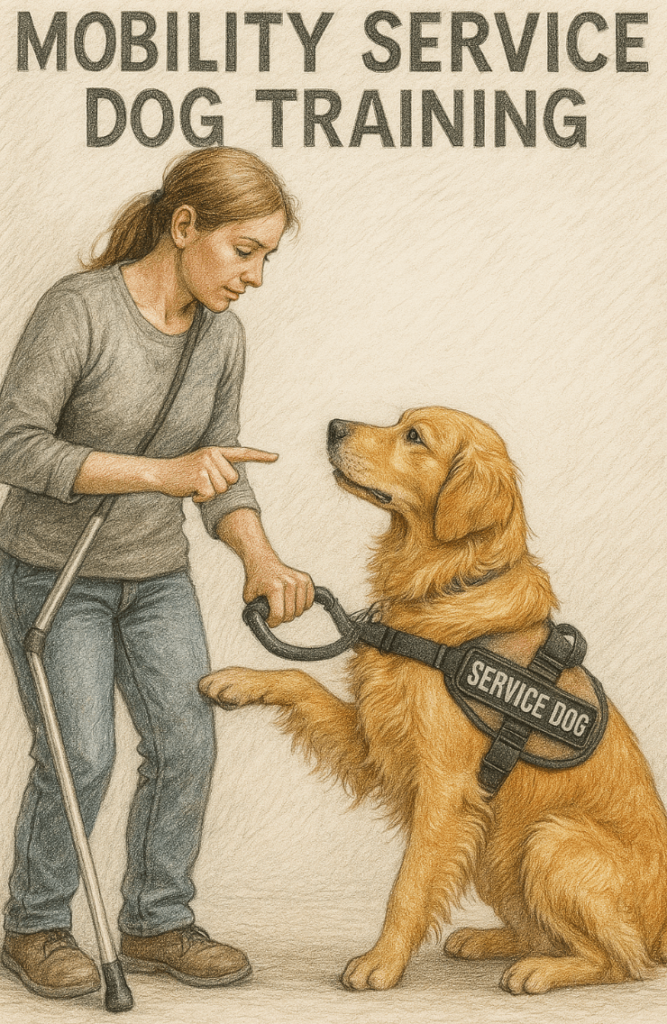Mobility Service Dog Training: Empowering Independence Through Canine Companionship
Mobility service dog training is a transformative process that equips specially trained dogs to assist individuals with mobility challenges. These remarkable animals provide physical support, perform tasks, and enhance the quality of life for their handlers, enabling greater independence and confidence. Whether helping someone navigate daily activities or offering stability during movement, mobility service dogs are invaluable companions. In this blog post, we’ll explore the intricacies of mobility service dog training, from selecting the right dog to mastering essential skills. By understanding the process and commitment involved, you can appreciate the profound impact these dogs have on their handlers’ lives.
Key Skills Taught in Mobility Service Dog Training
Training a mobility service dog involves teaching a variety of specialized skills tailored to the handler’s specific needs. These skills ensure the dog can perform tasks safely and effectively in real-world situations.
Retrieving Dropped Items:
Dogs are trained to pick up objects like keys, phones, or wallets, which may be difficult for handlers to reach.Opening and Closing Doors:
Using a rope or handle, mobility service dogs learn to open doors, drawers, and even refrigerators, providing greater accessibility.Assisting with Balance and Stability:
Dogs trained as braces help handlers stand, walk, or navigate uneven surfaces by providing steady support.Pulling Wheelchairs or Carts:
Stronger breeds are often trained to pull lightweight wheelchairs or assist with mobility aids over short distances.Turning Lights On and Off:
This task allows handlers to control their environment without needing to move around unnecessarily.
These foundational skills empower handlers to manage daily tasks more independently, showcasing the incredible versatility of mobility service dogs.
Key Skills Taught in Mobility Service Dog Training
Training a mobility service dog involves teaching a variety of specialized skills tailored to the handler’s specific needs. These skills ensure the dog can perform tasks safely and effectively in real-world situations.
Retrieving Dropped Items:
Dogs are trained to pick up objects like keys, phones, or wallets, which may be difficult for handlers to reach.Opening and Closing Doors:
Using a rope or handle, mobility service dogs learn to open doors, drawers, and even refrigerators, providing greater accessibility.Assisting with Balance and Stability:
Dogs trained as braces help handlers stand, walk, or navigate uneven surfaces by providing steady support.Pulling Wheelchairs or Carts:
Stronger breeds are often trained to pull lightweight wheelchairs or assist with mobility aids over short distances.Turning Lights On and Off:
This task allows handlers to control their environment without needing to move around unnecessarily.
These foundational skills empower handlers to manage daily tasks more independently, showcasing the incredible versatility of mobility service dogs.
Check this guide 👉Service Dog for Depression: Best 7 Expert Tips!
Check this guide 👉Autism Service Dog Tasks: Best 7 Expert Tips!
Check this guide 👉Therapy Dog vs Service Dog: Best 7 Expert Tips!

Benefits of Mobility Service Dogs | Challenges in Training |
|---|---|
Increased independence for handlers | Requires extensive time and patience |
Enhanced safety and confidence | High costs associated with professional training |
Assistance with daily tasks | Not all dogs are suitable candidates |
Emotional support and companionship | Handlers must commit to ongoing reinforcement |
Improved accessibility in public spaces | Potential behavioral setbacks during training |
Steps Involved in Mobility Service Dog Training
Training a mobility service dog is a structured and gradual process that requires dedication and consistency. Here’s an overview of the key steps involved.
Basic Obedience Training:
Dogs must master commands like sit, stay, come, and heel before advancing to more complex tasks.Public Access Training:
Dogs learn to remain calm and focused in crowded or noisy environments, ensuring they behave appropriately in public.Task-Specific Training:
Handlers identify specific tasks their dog will perform, such as retrieving items or providing balance support.Desensitization Exercises:
Dogs are exposed to various stimuli (e.g., loud noises, unfamiliar surfaces) to build confidence and adaptability.Handler-Dog Team Training:
The final phase focuses on strengthening the bond between the handler and the dog while practicing real-life scenarios.
Each step builds upon the previous one, culminating in a well-trained mobility service dog ready to assist their handler.
Common Misconceptions About Mobility Service Dog Training
Despite growing awareness, several misconceptions surround mobility service dog training. Addressing these myths helps clarify expectations for both handlers and trainers.
All Dogs Can Be Trained as Service Animals:
In reality, only a small percentage of dogs possess the temperament, health, and trainability required for service work.Training Is Quick and Easy:
The process typically takes 1-2 years of intensive training, requiring significant time and resources.Service Dogs Are Always Certified:
While certification programs exist, legal requirements vary by location, and some handlers train their own dogs.Service Dogs Never Get Distracted:
Even highly trained dogs can become distracted; ongoing reinforcement is necessary to maintain focus.Only People with Visible Disabilities Need Them:
Mobility service dogs assist individuals with a wide range of conditions, including invisible disabilities like chronic pain or fatigue.
Understanding these truths fosters greater appreciation for the complexity and value of mobility service dog training.
Tips for Handlers Working with Mobility Service Dogs
Living and working with a mobility service dog requires ongoing effort and communication. These tips can help handlers build a strong, effective partnership.
Establish Clear Commands:
Use consistent verbal cues and hand signals to avoid confusion during training and daily tasks.Prioritize Bonding Time:
Spend quality time playing, grooming, and simply relaxing with your dog to strengthen your connection.Practice Regularly:
Reinforce learned skills through daily practice sessions to keep your dog sharp and reliable.Monitor Your Dog’s Health:
Schedule regular vet check-ups to ensure your dog remains physically fit for their demanding role.Be Patient During Challenges:
Training setbacks are normal; approach them with understanding and persistence rather than frustration.
By following these tips, handlers can foster a harmonious and productive relationship with their mobility service dog.
Signs Your Dog May Struggle with Mobility Service Work
While many dogs thrive in service roles, others may not be suited for the demands of mobility assistance. Recognizing early warning signs can prevent frustration and ensure the dog’s well-being.
Difficulty Staying Calm in Public:
Overly reactive or anxious dogs may struggle to remain composed in busy environments.Lack of Focus During Training:
Dogs that frequently lose interest or ignore commands may lack the attention span needed for service work.Physical Limitations:
Joint issues, fatigue, or other health problems can hinder a dog’s ability to perform physically demanding tasks.Disinterest in Handler Interaction:
A strong bond is critical; dogs uninterested in engaging with their handler may not succeed in service roles.Inability to Adapt to New Situations:
Dogs that panic or shut down when faced with unfamiliar scenarios may find service work overwhelming.
Identifying these signs early allows trainers and handlers to make informed decisions about a dog’s suitability.
Ways to Support Mobility Service Dog Teams in Public
As awareness of service dogs grows, it’s important for the public to understand how to interact respectfully with mobility service dog teams. Here are some guidelines to follow.
Avoid Distracting the Dog:
Refrain from petting, calling, or making eye contact with a working service dog to ensure they remain focused on their handler.Respect Privacy:
Do not ask invasive questions about the handler’s disability; focus on polite and respectful interactions.Give Space in Crowded Areas:
Allow the team room to navigate comfortably without feeling crowded or pressured.Do Not Feed the Dog:
Feeding a service dog can disrupt their diet, training, and behavior. Always assume they are “on duty.”Educate Others:
Share information about service dog etiquette to promote understanding and inclusivity in your community.
Supporting mobility service dog teams creates a more welcoming and accessible environment for everyone.
Frequently Asked Questions About Mobility Service Dog Training
How long does it take to train a mobility service dog?
Training typically takes 1-2 years, depending on the dog’s progress and the tasks being taught.
Can I train my own dog to be a mobility service dog?
Yes, but it requires extensive knowledge, patience, and access to professional guidance.
What breeds are best suited for mobility service work?
Labrador Retrievers, Golden Retrievers, and German Shepherds are popular choices due to their size, temperament, and trainability.
Is it expensive to train a mobility service dog?
Professional training can cost $20,000-$50,000, though some organizations offer financial assistance.
Do mobility service dogs need special certification?
Certification requirements vary by region, but many handlers rely on self-training and documentation instead.
The Lifelong Impact of Mobility Service Dog Training
Mobility service dog training is a journey that transforms not only the life of the handler but also the dog itself. Through dedication, patience, and skill development, these extraordinary animals become indispensable partners, offering physical support, emotional comfort, and unwavering loyalty. For individuals facing mobility challenges, a trained service dog represents newfound freedom and independence. As awareness grows, so too does the appreciation for the hard work and compassion behind every successful mobility service dog team. If you’re considering this path, remember that the rewards far outweigh the effort—a mobility service dog isn’t just a helper; they’re a true companion.
Why Is My Cats Second Eyelid Showing? Best 7 Expert Tips! Understand causes, health signs, and how to respond when your cat’s third eyelid becomes visible.
How Do I Know If My Cat Died Peacefully? Best 7 Expert Tips! Discover the quiet signs of a peaceful feline passing and find comfort in their final moments.
Cat Allergy Eyes: Best 7 Expert Tips! Discover why your eyes react to cats and learn proven strategies for relief—without giving up your feline friend.
Why Do Abyssinian Cat Colors Matter? Best 7 Expert Tips! Discover the genetics, rare hues, and care secrets behind Abyssinian coat colors for a healthier, happier cat.





